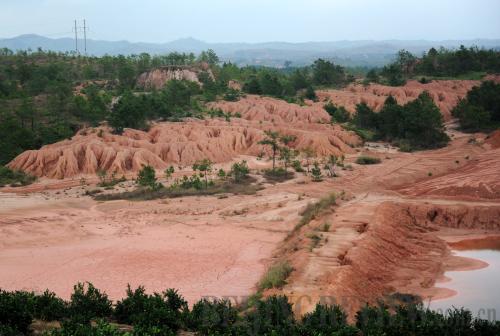|
 |
|
POLLUTION WARNING: Xinfeng county in Jiangxi Province preserves a section of damaged surface soil to serve as a warning for polluters on October 24, 2010 (ZHOU KE) |
China, known as a leading exporter of rare earth metals, is running into a dilemma common to countries rich in natural resources. As one of the world's greatest sources of rare earth metals, which are commonly used in high-tech industries such as aviation and physics, China has become the go-to source for these rare minerals. Consequently, pollution and other negative byproducts of the rare earth metal mining industry are starting to affect the quality of the areas where these mines are located.
Pollution: the inevitable result
China's rare earth reserves account for more than 30 percent of the world's total reserves, but its exports account for 97 percent of the world's total rare earth exports. Although the minerals are excavated and sold at a relatively low cost, the cost of the minerals in terms of environmental damage is quite high.
In the city of Ganzhou in Jiangxi Province, where more than one-third of China's rare earth metal reserves are found, the most commonly used extraction technique involves the use of sodium chloride (NaCl, or table salt) and oxalic acid to erode the earth and bring the minerals to the surface. However, this "mountain moving" process, as the locals refer to it, is very hazardous to the environment.
Statistics show that for every ton of rare earth that is brought to the surface, 200 square meters of green vegetation are destroyed. Add to that another 300 square meters of damaged surface soil, and you have a recipe for an environmental disaster.
"We just pour ammonium sulfate [a commonly used fertilizer] on the mountain, and then add some ammonium oxalate or another fertilizer to separate the rare earth [from the rest of the soil]," the manager of a rare earth mine in Ganzhou said to a CCTV program.
The use of highly corrosive acids in the area around Ganzhou's mountains has left the area in vulnerable condition.
A mining industry insider surnamed Yang explained that oxalate acid, a cheap and effective chemical that is often used in the rare earth mining process, is so corrosive that it is often used as an industrial solvent.
"Oxalate acid is more effective, and is popular in use, which means the cost is much lower. Once the acid is poured on a mountain, nothing can ever grow on it again," he said.
Another industry insider surnamed Liu explained the heavy environmental burden that has been created by the mining of these precious metals.
"Both Germany and Japan have advanced technologies that require the use of these metals," he said. "But they prefer to import them from China, because that way they can leave the pollution in China."
Smuggling: an emerging challenge
As the Chinese Government tightens rare earth metal exports, a new challenge is rising in the form of rare earth metal smuggling.
To elude government rules, some foreign companies are investing in their own rare earth metal processing centers located in China, aiming to harvest more of the minerals at a cheaper price.
"Foreign factories are strictly banned from rare earth mines," said one mining industry expert. "But there are no restrictions about exporting the alloys, which can contain rare earth elements."
He stated that many of these foreign manufacturers produce medical instruments, many of which are made with materials that contain rare earth metals, such as neodymium.
"There is no need to finish the whole process in China, including smelting, milling and molding" he said. "As long as they have the alloy, they can export it legally."
There are even some companies that illegally label the alloy as ordinary iron, allowing them to skirt export regulations.
In July, customs officers in Guangxi Zhuang Autonomous Region uncovered a smuggling operation involving more than 4,000 tons of rare earth metals and alloys. The materials were improperly labeled to avoid detection by authorities. Many rare earth alloys are marked as being iron, marble or other materials that are legal for exporting.
Statistics show that the total export of neodymium magnets rose to approximately 1,110 tons in September, over three times the amount that was exported last January. The increasing amount of rare earth exports does not fall in line with the export policies, which state that only 13,000 tons of rare earth may be exported annually.
According to the Ministry of Commerce, the large-scale exploitation of China's rare earth reserves means that only 27 million tons of the material are left in China. Experts say that this amount will only sustain China for 20 more years; at that time, China will have to depend on rare earth metal exports.
| 